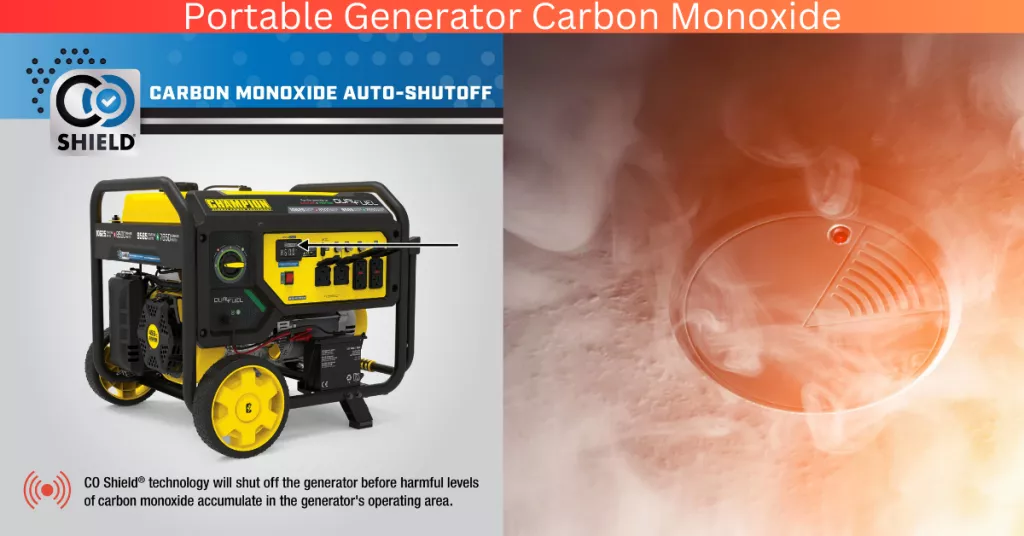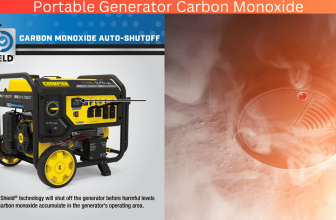I remember the first time I used my portable generator. I was excited to have a backup power source during a blackout, but I soon realized that there are many safety precautions to consider.
Portable generators can be extremely useful, but they can also be dangerous if not used properly. That’s why it’s important to know essential safety tips for using portable generators.
In this article, I’m going to share with you some of the most important safety tips that I’ve learned over the years. Whether you’re using a portable generator for the first time or you’ve used one before, it’s always a good idea to review these safety tips to ensure that you and your loved ones stay safe.
So, let’s dive in and learn how to use portable generators safely and effectively.
Key Takeaways
- Always use portable generator outdoors to avoid carbon monoxide poisoning and reduce electrocution risk
- Keep generator dry and on a dry surface with a canopy or tarp
- Use proper gauge and length of extension cords to avoid overheating, voltage drop, and electrical fires
- Prioritize safety, educate others, and have an emergency preparedness plan in place.

Always Use a Portable Generator Outdoors
You gotta keep that generator outside, folks! Don’t bring it indoors – it’s meant for the great outdoors. Portable generators emit carbon monoxide, a deadly gas that can accumulate quickly in enclosed spaces. Even if you think you’ve got enough ventilation, it’s not worth the risk.
So, set it up outside, at least 20 feet away from any windows, doors, or vents. Not only will using your generator outside keep you safe from carbon monoxide poisoning, but it will also reduce the risk of electrocution.
Wet surfaces and electrical equipment don’t mix, so don’t use your generator in wet conditions or near standing water. Keep the generator dry by covering it with a canopy or tarp, and make sure the generator is placed on a dry surface.
Keep the Generator Dry
To avoid damaging your portable generator, make sure it stays dry at all times. Moisture can corrode the generator’s parts and cause serious malfunctions. Here are some tips to keep your generator dry:
- Place the generator on a dry surface: When setting up your generator, make sure it’s on a dry surface. Moisture can seep through the ground and damage the generator’s bottom.
- Cover the generator: When not in use, cover the generator with a waterproof cover. This will prevent rain, snow, or other forms of moisture from getting inside the generator.
- Keep the generator away from water sources: Water and electricity don’t mix. Avoid placing your generator near pools, ponds, or other sources of water.
- Don’t use the generator in wet conditions: Never use your generator in wet conditions. Not only is this dangerous, but it can also damage the generator.
Remember, keeping your generator dry is essential for its longevity and proper functioning. Now let’s move on to the next step, which is using the right extension cords.
Use the Right Extension Cords
Using the right extension cords is crucial when it comes to using portable generators safely.
From my experience, it’s important to understand the proper gauge and length of the extension cords you use to prevent any issues.
Overloading the generator is another concern to keep in mind, so make sure to use cords that can handle the amount of power being generated.
Importance of Proper Gauge and Length
Make sure your portable generator is connected with the proper gauge and length of extension cord to avoid any potential safety hazards. Using the wrong gauge or length of extension cord can cause overheating, voltage drop, and even electrical fires. Here are some important things to keep in mind when selecting the right extension cord for your generator:
- Gauge: The gauge of an extension cord refers to its thickness. The thicker the cord, the lower the gauge number. For most portable generators, a 10-12 gauge extension cord is recommended. Using a lower gauge cord can cause voltage drop, which can damage your appliances and even pose a fire hazard.
- Length: The longer the cord, the more voltage drop it will experience. This is why it’s important to use the shortest cord possible to connect your generator to your appliances. If you need to use a longer cord, make sure it has a higher gauge to compensate for the voltage drop.
By using the proper gauge and length of extension cord, you can ensure that your portable generator is working safely and efficiently. However, it’s important to remember that even with the right extension cord, you can still overload your generator. In the next section, we’ll discuss some tips on how to avoid overloading your generator.
Avoid Overloading the Generator
Overloading your generator can lead to significant damage, and it’s crucial to be mindful of your power usage to avoid such a situation. Many people tend to overload their portable generators by plugging in too many appliances simultaneously. This can cause the generator to overheat, and in the worst-case scenario, it can also lead to a fire outbreak.
Therefore, always be mindful of the wattage of your generator and the appliances you’re using to prevent overloading. To avoid overloading your generator, you must always keep track of the wattage of each appliance you’re using. Make sure that the total wattage of the appliances you’re using doesn’t exceed the wattage output of your generator.
Overloading can also occur if you use an extension cord that’s too long or too thin. Therefore, always use a proper gauge and length of extension cords. With these precautions in mind, you can ensure that your generator runs smoothly, and you can enjoy its benefits without any worries.
It’s crucial to keep your portable generator in good working condition. One of the ways to do so is by turning it off and unplugging all appliances before refueling. Refueling a running generator can lead to a fire outbreak, which can cause significant damage to your surroundings. Therefore, it’s essential to wait for the generator to cool down before refueling.
By following these safety tips, you can ensure that you use your portable generator effectively and safely.
Turn Off the Generator and Unplug Appliances Before Refueling
I want to talk about the importance of turning off generators and unplugging appliances before refueling. This is an essential safety measure because fuel is highly flammable and can easily ignite.
Refueling a generator that’s still running or with appliances still plugged in can lead to fire and explosion risks. It’s recommended to allow the generator to cool down before refueling to avoid accidental burns or injuries.
Make sure to turn off the generator and unplug appliances before refueling.
Fire and Explosion Risks

Be warned – if you don’t take proper precautions, using a portable generator could easily result in a dangerous fire or explosion. One of the biggest risks is fueling the generator while it’s still hot. The heat from the engine can ignite the gasoline, causing a fire or explosion. To prevent this from happening, always allow the generator to cool down before refueling.
Here are some other important tips to keep in mind to avoid fire and explosion risks:
- Store fuel in a safe, cool, and dry location away from the generator.
- Never add fuel to a running generator or a generator that’s still hot.
- Keep the generator at least 10 feet away from your home or other structures.
- Make sure the generator is on a level surface and never operate it in a confined space.
By following these safety tips, you can avoid the dangerous risks associated with portable generator use. Remember to always prioritize safety when using your generator. Allow the generator to cool down before refueling to prevent any potential accidents.
Allow Generator to Cool Down Before Refueling
Always remember to let your generator cool down before refueling to prevent any potential accidents that could harm you or your loved ones. Generators can become extremely hot while in use, and it’s important to give them time to cool off before adding more fuel.
Refueling a hot generator can cause the fuel to ignite and result in a fire or explosion. This is why it’s important to turn off the generator and wait for it to cool down before adding more fuel.
It’s also important to use the correct type of fuel for your generator. Using the wrong type of fuel can cause your generator to malfunction and potentially cause harm. Once you’ve determined the correct type of fuel, make sure to store it in a safe place away from any heat sources.
Remember, safety should always be a top priority when using a portable generator. As you wait for your generator to cool down, it’s important to keep children and pets away from the area. They may not fully understand the potential dangers of a hot generator and could accidentally touch or knock it over, causing harm to themselves or others.
By taking these simple precautions, you can ensure that your portable generator is used safely and effectively.
Keep Children and Pets Away
Ensure children and pets stay a safe distance away from the portable generator to avoid any potential accidents. Portable generators can be dangerous if they’re mishandled or used improperly, which is why it’s important to keep children and pets at a safe distance from them.
Here are three things to keep in mind when it comes to keeping children and pets away from the generator:
- Create a boundary: Set up a physical boundary around the generator to prevent children and pets from getting too close. You can use cones, tape, or other markers to create a safe distance.
- Supervise children and pets: Even with a boundary in place, it’s important to supervise children and pets around the generator. Keep an eye on them at all times and make sure they don’t wander too close.
- Educate children about generator safety: Teach your children about the dangers of portable generators and why they need to stay away from them. Make sure they understand that the generator isn’t a toy and can cause serious harm if mishandled.
Now that you know how to keep children and pets safe around the generator, it’s important to also know how to store fuel safely.
Store Fuel Safely
You don’t want to risk an explosive situation, do you? So make sure to store your fuel for the generator properly.
It’s important to remember that gasoline is highly flammable, and improper storage of fuel can lead to serious accidents. Keep your fuel in a cool, dry, and well-ventilated area, away from any potential sources of ignition such as open flames, electrical sparks, or heat sources.
When storing fuel, it’s also important to use approved containers that are specifically designed for storing gasoline or diesel fuel. These containers should be made of high-density polyethylene (HDPE) and have a tight-fitting lid to prevent any spills.
Remember to label your containers with the type of fuel and the date it was stored. By taking these precautions, you can safely store and use your generator without any unnecessary risks.
Now, let’s talk about the next important step: knowing how to use the generator.
Know How to Use the Generator
Understanding the proper operation of a generator can be beneficial in ensuring it runs smoothly and efficiently. It’s important to read the owner’s manual thoroughly and become familiar with the different parts and functions of the generator. One key aspect of using a generator safely is to never operate it indoors or in an enclosed area. This can lead to carbon monoxide poisoning, which can be deadly.
To help you better understand the importance of safe generator use, take a look at the following table:
| Generator Mistake | Consequence | Solution |
|---|---|---|
| Running a generator indoors | Carbon monoxide poisoning or death | Only operate generators outdoors and in well-ventilated areas |
| Overloading the generator | Damage to appliances or the generator itself | Calculate the wattage needed and only plug in necessary appliances |
| Refueling a hot generator | Fire or explosion | Allow the generator to cool down before refueling |
By following these safety tips and being aware of the potential dangers, you can use your generator with confidence and avoid any disasters. It’s important to remember that generators are powerful tools and should be treated with respect. In the next section, we’ll talk about the importance of having a carbon monoxide detector.
Have a Carbon Monoxide Detector
I can’t stress enough the importance of having a carbon monoxide detector if you’re using a portable generator. Early detection is crucial in preventing a deadly outcome.
Placement is also key – make sure it’s near sleeping areas and on every level of your home. And don’t forget about maintenance – test the detector regularly to ensure it’s functioning properly.
Importance of Early Detection
Spotting potential generator issues early on can save you from costly damages and dangerous situations down the road. One of the most important things to remember is to keep a close eye on your generator’s performance. Any unusual noises or smells should be investigated immediately. Don’t wait until it’s too late to address an issue.
Getting ahead of the problem can help prevent further damage to your generator, and more importantly, protect you and your loved ones from harm. Early detection is crucial when it comes to generator safety. That’s why it’s important to perform regular maintenance checks, including oil changes and filter replacements.
In addition, make sure to keep your generator in a well-ventilated area to avoid any build-up of harmful gases. By following these simple steps, you can ensure that your generator is running smoothly and safely.
The next step is to consider proper placement and maintenance for your generator.
Placement and Maintenance
To ensure your generator runs efficiently, it’s important to properly place and maintain it. Here are some tips to keep in mind:
- Choose a safe location: Place your generator in a well-ventilated area that’s at least 20 feet away from your home, garage, or other buildings. Make sure it’s on a dry, level surface and away from any flammable materials like leaves, grass, or debris.
- Keep it dry: Protect your generator from rain, snow, or other moisture by using a canopy or shelter. Wet conditions can damage the generator and increase the risk of electrocution.
- Check the oil and fuel levels: Before starting your generator, make sure it has enough oil and fuel to run properly. Refer to the manufacturer’s instructions for specific details on how to check and fill the levels.
- Regularly inspect and clean: Regular maintenance is crucial to keeping your generator running smoothly. Inspect and clean the air filter, spark plugs, and other parts as recommended by the manufacturer.
By following these placement and maintenance tips, you can ensure your generator is safe and effective. Regular maintenance is also important to keep your generator working properly, so let’s take a look at some essential maintenance tasks.
Regular Maintenance
Make sure you’re keeping up with regular maintenance on your portable generator, or you could be putting yourself and others in danger. It’s important to regularly check the oil level, air filter, and spark plug. Neglecting these simple tasks can result in your generator not working properly or even causing a fire or carbon monoxide poisoning.
Additionally, make sure to follow the manufacturer’s recommended maintenance schedule. This may include changing the oil and air filter after a certain number of hours of use, inspecting the fuel lines, and checking the battery. By keeping up with regular maintenance, you’ll not only ensure your generator is working properly when you need it, but you’ll also extend its lifespan.
In the event of an emergency, you’ll want to be prepared. One way to prepare is by having a designated area to store your generator and keeping it easily accessible.
Emergency Preparedness
I believe that it’s crucial to have an emergency preparedness plan in place, especially when using a portable generator.
Firstly, it’s vital to ensure that everyone in your household knows what to do in the event of an emergency.
Secondly, communication is key – make sure you have a way to contact family members, emergency services, and neighbors if needed.
Lastly, always prioritize safety – familiarize yourself with safety protocols and ensure that you have the necessary tools and equipment to handle any potential emergencies.
Have a Plan in Place
Make sure there’s a clear plan in place before operating a portable generator, including where to place it and how to properly connect it to appliances. Here are some things to consider when making your plan:
- Identify a safe and dry place to operate the generator, away from any flammable materials or structures.
- Make sure the generator is properly grounded to prevent electrical shock.
- Have a supply of fuel on hand, and ensure it’s stored safely away from the generator.
- Take the time to familiarize yourself with the generator’s manual and safety features before use.
It’s important to remember that portable generators can be dangerous if not used properly. By having a plan in place and taking the necessary precautions, you can safely operate your generator in case of an emergency.
Next, let’s talk about the importance of communication and safety when using a portable generator.
Importance of Communication and Safety
Communication with others is key in safely operating a portable generator during an emergency. Not only should you let others know about your generator use, but you should also have a clear communication plan in place for emergency situations. This plan should include a designated family member or friend who can be contacted in case of an emergency, as well as a plan for notifying neighbors if there is a power outage.
It is also important to ensure that everyone in the household understands basic generator safety. This includes keeping the generator at least 20 feet away from the house and ensuring it is properly grounded. Additionally, it is important to never operate a generator indoors or in an enclosed space, as this can lead to carbon monoxide poisoning. By communicating with others and ensuring everyone is on the same page about generator safety, you can help prevent accidents and ensure the safety of your family and neighbors.
| Safety Tips | Importance |
|---|---|
| Keep the generator dry | Prevents electrocution |
| Use heavy-duty extension cords | Prevents overheating and fires |
| Turn off the generator before refueling | Prevents fires and explosions |
| Store fuel in a safe location | Prevents accidental spills and fires |
| Have a carbon monoxide detector | Prevents carbon monoxide poisoning |
Frequently Asked Questions
How much fuel should I store for my portable generator?
I generally store enough fuel for at least 8-10 hours of use for my portable generator. It’s important to never overfill the tank and to store fuel in a safe, well-ventilated area away from any flames or sparks.
Can I use any type of extension cord with my portable generator?
Yes, but it must be rated for the wattage of your generator and have a grounding wire. Using an insufficient or damaged cord can cause electrical hazards and damage your equipment. Always prioritize safety.
What do I do if my carbon monoxide detector goes off while using my generator?
If my carbon monoxide detector goes off while using my generator, I immediately shut it down and move it outside. I open windows and doors for ventilation and contact a professional to inspect my home for any potential leaks.
How often should I perform maintenance on my portable generator?
I perform maintenance on my portable generator every 50-60 hours of use or at least once a year. It includes checking the oil, air filter, spark plug, and fuel system for any issues. Safety is key!
What should I do if I experience a power outage and need to use my portable generator for an extended period of time?
If I experience a power outage and need to use my portable generator for an extended period, I should make sure to only use it outdoors and keep it at least 10 feet away from my home. I should also avoid overloading it and always have a fire extinguisher nearby.
Conclusion
In conclusion, using a portable generator is a convenient way to have power when you need it, but it also comes with risks. It is essential to take the necessary safety measures to avoid any accidents or harm.
Always remember to use the generator outdoors, keep it dry, and use the right extension cords. Turn it off and unplug appliances before refueling, keep children and pets away, and know how to use it properly.
Additionally, having a carbon monoxide detector, regular maintenance, and emergency preparedness are crucial for your safety.
By following these essential safety tips, you can ensure that your portable generator serves its purpose without any unwanted incidents. Remember, safety always comes first!





